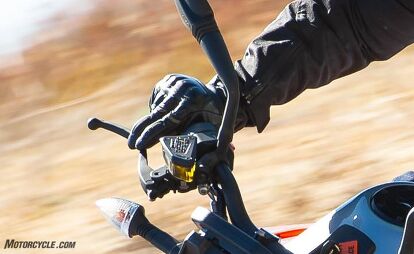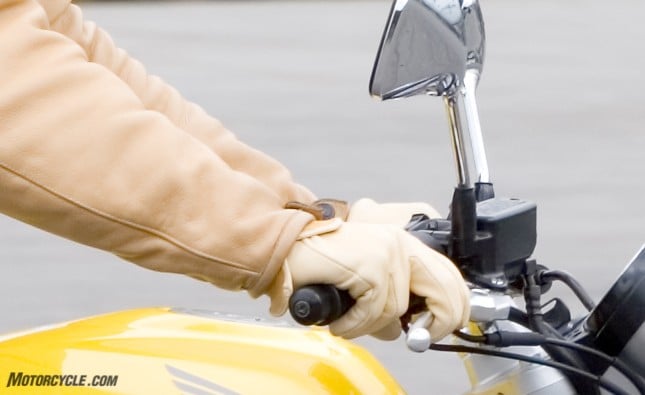New Rider: Two-Fingered Braking

This advanced braking technique cuts your reaction time
Many of us are products of MSF rider education courses and are quite familiar with the admonition to use all four fingers on the front brake for maximum control. While I support that rule for beginning riders, it is one that we quickly outgrow once we start logging miles out in the real world. I first began to notice the shortcomings of this rule when I anticipated in traffic that I might need to use the brakes. Covering the brake lever with four fingers makes it quite difficult to control the throttle. Then there were the magazine photos of all my heroes blatantly using two fingers on the front brake. Two-fingered braking appeared to address the problems I was encountering as an urban rider. (It was only later that I learned that it opened up a new world of braking techniques.)
This began my transition to two-fingered braking, and although more than a quarter-century has passed, I can still remember the moment when I first felt all the skills – smoothly rolling the throttle off and back on while my fingers slid over the brake lever during shifts or the act of naturally beginning my application of the front brake as I rolled off the throttle for a stop – synchronize perfectly. In the days leading up to this moment, shifts had been uneven, requiring much more attention than I expected when I began pursuing this skill.
Some will argue that you should use more than two fingers because you have better control or that you could trap your other fingers and limit your braking power in a panic stop. However, my experience is that almost all modern hydraulic braking systems have more than enough power to bring a motorcycle to a stop with two fingers (or even one finger on some bikes, for that matter), and a properly maintained and adjusted brake system will keep you from trapping fingers in a maximum braking scenario. What is of paramount importance is using the proper technique for resting two fingers on the brake lever even when not braking.
The first step is to make sure your throttle hand is in the wrist down position. That means that when you rest your index finger and middle finger on the brake lever, you make a straight line from your fingers across the back of your hand to your wrist and up your arm. What this does is make you naturally close the throttle as you reach for the front brake lever.
While in your garage, sit on your bike in your riding position and practice rolling the throttle on and off with your fingers on the brake lever. As you roll off the gas, smoothly start squeezing the brake lever. Reverse the steps to begin applying the throttle again. Once you have a feel for that, practice quickly rolling the throttle off and back on as you would when upshifting. Here the trick is to not apply any pressure to the brake lever while still letting your fingers slide back and forth over it.
After you’re comfortable doing this in your garage, take the exercise to a quiet street. For me, it helped to imagine my two fingers were double-jointed as they flexed backward during the quick closing of the throttle for shifts. Next, incorporate this technique in all your rides. You may find that it takes a lot more concentration to shift and brake smoothly for a while. The effort is worth it. Gradually, braking with just two fingers will become second nature, and you’ll have it in your tool kit for when you need it – like when someone pulls out in front of you.
Once you’ve mastered shifting with your fingers resting on the brake lever in addition to the task of two-fingered braking, you’ll notice that you start combining rolling off the throttle and braking. Now, it’s time to move on to even more advanced braking skills, like how to brake while downshifting or trail braking.

Like most of the best happenings in his life, Evans stumbled into his motojournalism career. While on his way to a planned life in academia, he applied for a job at a motorcycle magazine, thinking he’d get the opportunity to write some freelance articles. Instead, he was offered a full-time job in which he discovered he could actually get paid to ride other people’s motorcycles – and he’s never looked back. Over the 25 years he’s been in the motorcycle industry, Evans has written two books, 101 Sportbike Performance Projects and How to Modify Your Metric Cruiser, and has ridden just about every production motorcycle manufactured. Evans has a deep love of motorcycles and believes they are a force for good in the world.
More by Evans Brasfield



































Comments
Join the conversation
thanks for the video. I might be a bit clumsy and worry that when rolling off the throttle my most proximal phalanx is in contact with the brake lever (as seen in the video) limiting the range of motion compared to having the middle or distal phalanx pulling at it. If you have longer travel in the brakes (mushier brakes) could this prevent you from achieving full braking power?
thanks again!
I vaguely remember trying to do the 2-fingers-lever-thing a while ago, having the same thoughts as many about the other fingers getting in the way, not being able to fully pull on the brake lever, not controlling the throttle enough, etc.
Truth is, I cannot remember what made me change, or when that really happened. I probably forced myself to do it for a couple of rides. I don’t think I could ever train myself back to 4 fingers on either lever.